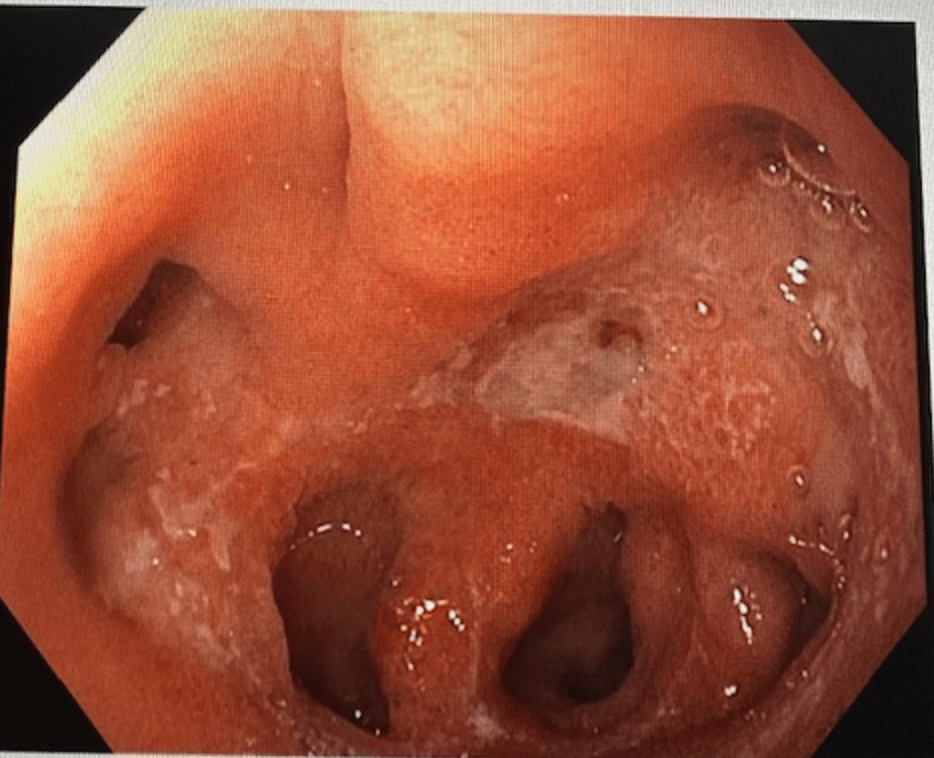Tuesday Poster Session
Category: Small Intestine
P6270 - H. pylori-Associated Duodenal Ulcer with Surrounding Duodenal Diverticulosis
Tuesday, October 28, 2025
10:30 AM - 4:00 PM PDT
Location: Exhibit Hall
- AD
Amr Dokmak, MD (he/him/his)
Brooklyn Hospital Center
Brooklyn, NY
Presenting Author(s)
Amr Dokmak, MD1, Arnold Forlemu, MD1, Camelia Ciobanu, MD1, Madhavi Reddy, MD2, Jamil Shah, MD1
1Brooklyn Hospital Center, Brooklyn, NY; 2The Brooklyn Hospital Center, Brooklyn, NY
Introduction: Duodenal diverticulosis is a relatively rare condition, with an incidence of about 0.2% to 5% in the general population. These diverticula are typically asymptomatic. However, in some cases, they can lead to bleeding or perforation. Duodenal ulcers are more common and are usually caused by H pylori infection or NSAID use. We hereby present the case of a 52-year-old woman with extensive duodenal diverticula and an H pylori associated ulcer discovered during esophagogastroduodenoscopy.
Case Description/
Methods: A 52-year-old woman presented to clinic with chronic dyspepsia not improved with PPIs. Physical exam and laboratory investigations were unremarkable. Endoscopy revealed five large and small diverticula in the duodenal bulb (Figure 1). The diverticula were round, well-defined, and appeared to be mildly inflamed. No signs of active bleeding, or obstruction were noted. The surrounding mucosa had a 1 cm clean-base duodenal bulb ulcer. Gastric biopsies were positive for H pylori. She was successfully treated with Bismuth based quadruple therapy and PPI for ulcer healing with subsequent resolution of her dyspepsia.
Discussion: The exact cause of duodenal diverticulosis remains unclear. Some studies suggest that it may be related to increased intraluminal pressure, particularly in areas of the duodenum where the biliary and pancreatic ducts converge. Other potential etiologies include congenital abnormalities, chronic inflammation, or an acquired weakening of the duodenal wall over time. In most cases, duodenal diverticulosis is a benign condition that requires no specific treatment. Complications such as diverticulitis, perforation, and hemorrhage should be treated accordingly. Surgical intervention is generally reserved for patients who develop severe complications refractory to medical or endoscopic management.
Our patient had numerous duodenal bulb diverticula with a surrounding clean-based ulcer that is likely H pylori associated. The diverticula possibly developed from the chronic inflammation driven by the H pylori infection. Our case highlights the rare discovery of an H pylori associated ulcer with numerous surrounding duodenal diverticula and emphasizes the importance of thorough endoscopic evaluation in patients with unexplained dyspeptic symptoms to identify coexisting gastrointestinal conditions.

Figure: Figure 1. Duodenal bulb ulcer with numerous surrounding diverticula
Disclosures:
Amr Dokmak indicated no relevant financial relationships.
Arnold Forlemu indicated no relevant financial relationships.
Camelia Ciobanu indicated no relevant financial relationships.
Madhavi Reddy indicated no relevant financial relationships.
Jamil Shah indicated no relevant financial relationships.
Amr Dokmak, MD1, Arnold Forlemu, MD1, Camelia Ciobanu, MD1, Madhavi Reddy, MD2, Jamil Shah, MD1. P6270 - <i>H. pylori</i>-Associated Duodenal Ulcer with Surrounding Duodenal Diverticulosis, ACG 2025 Annual Scientific Meeting Abstracts. Phoenix, AZ: American College of Gastroenterology.
1Brooklyn Hospital Center, Brooklyn, NY; 2The Brooklyn Hospital Center, Brooklyn, NY
Introduction: Duodenal diverticulosis is a relatively rare condition, with an incidence of about 0.2% to 5% in the general population. These diverticula are typically asymptomatic. However, in some cases, they can lead to bleeding or perforation. Duodenal ulcers are more common and are usually caused by H pylori infection or NSAID use. We hereby present the case of a 52-year-old woman with extensive duodenal diverticula and an H pylori associated ulcer discovered during esophagogastroduodenoscopy.
Case Description/
Methods: A 52-year-old woman presented to clinic with chronic dyspepsia not improved with PPIs. Physical exam and laboratory investigations were unremarkable. Endoscopy revealed five large and small diverticula in the duodenal bulb (Figure 1). The diverticula were round, well-defined, and appeared to be mildly inflamed. No signs of active bleeding, or obstruction were noted. The surrounding mucosa had a 1 cm clean-base duodenal bulb ulcer. Gastric biopsies were positive for H pylori. She was successfully treated with Bismuth based quadruple therapy and PPI for ulcer healing with subsequent resolution of her dyspepsia.
Discussion: The exact cause of duodenal diverticulosis remains unclear. Some studies suggest that it may be related to increased intraluminal pressure, particularly in areas of the duodenum where the biliary and pancreatic ducts converge. Other potential etiologies include congenital abnormalities, chronic inflammation, or an acquired weakening of the duodenal wall over time. In most cases, duodenal diverticulosis is a benign condition that requires no specific treatment. Complications such as diverticulitis, perforation, and hemorrhage should be treated accordingly. Surgical intervention is generally reserved for patients who develop severe complications refractory to medical or endoscopic management.
Our patient had numerous duodenal bulb diverticula with a surrounding clean-based ulcer that is likely H pylori associated. The diverticula possibly developed from the chronic inflammation driven by the H pylori infection. Our case highlights the rare discovery of an H pylori associated ulcer with numerous surrounding duodenal diverticula and emphasizes the importance of thorough endoscopic evaluation in patients with unexplained dyspeptic symptoms to identify coexisting gastrointestinal conditions.

Figure: Figure 1. Duodenal bulb ulcer with numerous surrounding diverticula
Disclosures:
Amr Dokmak indicated no relevant financial relationships.
Arnold Forlemu indicated no relevant financial relationships.
Camelia Ciobanu indicated no relevant financial relationships.
Madhavi Reddy indicated no relevant financial relationships.
Jamil Shah indicated no relevant financial relationships.
Amr Dokmak, MD1, Arnold Forlemu, MD1, Camelia Ciobanu, MD1, Madhavi Reddy, MD2, Jamil Shah, MD1. P6270 - <i>H. pylori</i>-Associated Duodenal Ulcer with Surrounding Duodenal Diverticulosis, ACG 2025 Annual Scientific Meeting Abstracts. Phoenix, AZ: American College of Gastroenterology.
